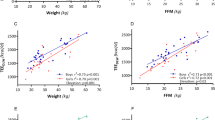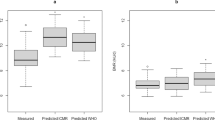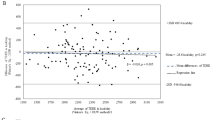Abstract
Objectives: To measure total energy expenditure (TEE) and total body water (TBW) in healthy Swedish children 9 or 14 months of age. To compare their TEE with current recommendations for energy intake. To define their body composition and relate this to energy expenditure.
Design: Children were investigated at 9 or 14 months. The following variables were measured: TEE and TBW (by the doubly labelled water method), weight and length. Total body fat (TBF), sleeping metabolic rate, activity energy expenditure and physical activity level (PAL) were calculated.
Subjects: Thirty infants 9 months of age and 29 children 14 months of age.
Results: TEE was 323±38, 322±29, 313±23 and 331±28 kJ/kg/day in 9-month-old girls, 9-month-old boys, 14-month-old girls and 14-month-old boys, respectively. At 9 months of age girls and boys contained 29.6±4.8 and 29.7±4.5% TBF, respectively. At 14 months the corresponding figures were 29.1±4.3 and 28.2±4.3%. There was a significant negative relationship between PAL and %TBF (r=−0.81, P<0.001, n=59).
Conclusions: Measured TEE plus calculated energy cost of growth confirm previous estimates that the physiological energy requirements of children 9 and 14 months of age are 15–20% lower than current recommendations for energy intake. One possible interpretation of the relationship between PAL and %TBF is that children with a high TBF content are less physically active than children with less TBF. However, this relationship needs further studies.
This is a preview of subscription content, access via your institution
Access options
Subscribe to this journal
Receive 12 print issues and online access
$259.00 per year
only $21.58 per issue
Buy this article
- Purchase on Springer Link
- Instant access to full article PDF
Prices may be subject to local taxes which are calculated during checkout

Similar content being viewed by others
References
Altman, DG (1999). Practical Statistics for Medical Research, pp277–324, London: Chapman & Hall
Armitage, P (1971). Statistical Methods in Medical Research, pp217–225, New York: Halsted Press, John Wiley
Ball, EJ, O'Connor, J, Abbot, R, Steinbeck, KS, Davies, PSW, Wishart, C, Gaskin, KJ & Baur, LA (2001). Total energy expenditure, body fatness, and physical activity in children aged 6–9 y. Am. J. Clin. Nutr., 74, 524–528.
Black, AE, Prentice, AM & Coward, WA (1986). Use of food quotients to predict respiratory quotients for doubly-labelled water method of measuring energy expenditure. Hum. Nutr. Clin. Nutr., 40C, 381–391.
de Bruin, NC, Degenhart, HJ, Gàl, S, Westerterp, KR, Stijnen, T & Visser, HKA (1998). Energy utilization and growth in breast-fed and formula-fed infants measured prospectively during the first year of life. Am. J. Clin. Nutr., 67, 885–896.
Butte, NF (1996). Energy requirements of infants. Eur. J. Clin. Nutr., 50, (Suppl 1) S24–36.
Butte, NF, Hopkinson, JM, Wong, WW, Smith, EOB & Ellis, KJ (2000a). Body composition during the first 2 years of life: an updated reference. Pediatr. Res., 47, 578–585.
Butte, NF, Wong, WW, Hopkinson, JM, Heinz, CJ, Mehta, NR & Smith, EOB (2000b). Energy requirements derived from total energy expenditure and energy deposition during the first 2 y of life. Am. J. Clin. Nutr., 72, 1558–1569.
Davies, PSW (1998). Energy requirements for growth and development in infancy. Am. J. Clin. Nutr., 68, (Suppl) 939–943.
Davies, PSW, Coward, WA, Gregory, J, White, A & Mills, A (1994). Total energy expenditure and energy intake in the pre-school child: a comparison. Br. J. Nutr., 72, 13–20.
Davies, PSW, Gregory, J & White, A (1995). Physical activity and body fatness in pre-school children. Int. J. Obes. Relat. Metab. Disord., 19, 6–10.
Davies, PSW, Wells, JCK, Hinds, A, Day, JME & Laidlaw, A (1997). Total energy expenditure in 9 month and 12 month infants. Eur. J. Clin. Nutr., 51, 249–252.
FAO/WHO/UNU (1985). Energy and Protein Requirements, Report of a Joint expert Consultation. WHO Technical Report Series, no. 724 Geneva: WHO
Fomon, SJ, Haschke, F, Ziegler, EE & Nelson, SE (1982). Body composition of reference children from birth to age 10 years. Am. J. Clin. Nutr., 35, 1169–1175.
Hoffman, DJ, Sawaya, AL, Coward, WA, Wright, A, Martins, PA, de Nascimento, C, Tucker, KL & Roberts, SB (2000). Energy expenditure of stunted and nonstunted boys and girls living in the shantytowns of Sao Paulo, Brazil. Am. J. Clin. Nutr., 72, 1024–1034.
Ivarsson, A, Persson, Lå, Nyström, L, Ascher, H, Cavell, B, Danielsson, L, Dannaeus, A, Lindberg, T, Lindquist, B, Stenhammar, L & Hernell, O (2000). Epidemic of coeliac disease in Swedish children. Acta Paediatr., 89, 165–171.
Jones, PJH, Winthrop, AL, Scholler, DA, Swyer, PR, Smith, J, Filler, RM & Heim, T (1987). Validation of doubly labelled water for assessing energy expenditure in infants. Pediatr. Res., 21, 242–246.
Koletzko, B, Chen, W, Girardet, J-P, Klish, W, Leung, S & Tabacco, O (2000). Obesity in Children and Adolescents: Current Views and Future Directions, Working group report Boston, MA: World Congress of Pediatric Gastroenterology, Hepatology and Nutrition
Li, R, O'Connor, L, Buckley, D & Specker, B (1995). Relation of activity levels to body fat in infants 6 to 12 months of age. J. Pediatr., 126, 353–357.
Prentice, AM, Lucas, A, Vasquez-Velasquez, L, Davies, PSW & Whitehead, RG (1988). Are current dietary guidelines for young children a prescription for overfeeding?. Lancet, 5, 1066–1069.
Rising, R, Harper, IT, Fontvielle, AM, Ferraro, RT, Spraul, M & Ravussin, E (1994). Determinants of total daily energy expenditure: variability in physical activity. Am. J. Clin. Nutr., 59, 800–804.
Roberts, SB, Coward, WA, Schlingenseipen, KH, Nohria, V & Lucas, A (1986). Comparison of the doubly labeled water (2H218O) method with indirect calorimetry and a nutrient balance study for simultaneous determination of energy expenditure, water intake, and metabolizable energy intake in preterm infants. Am. J. Clin. Nutr., 44, 315–322.
Schofield, WN, Schofield, C & James, WPT (1985). Basal metabolic rate: review and prediction. Hum. Nutr. Clin. Nutr., 39, 1–96.
Speakman, JR (1997). Doubly Labelled Water. Theory and Practice, London: Chapman & Hall
Stunkard, AJ, Berkowitz, RI, Stallings, VA & Scholler, DA (1999). Energy intake, not energy output, is a determinant of body size in infants. Am. J. Clin. Nutr., 69, 524–530.
Vasquez-Velasquez, L (1988). Energy expenditure and physical activity of malnourished Gambian infants. Proc. Nutr. Soc., 47, 233–239.
de Weir, JB (1949). New methods for calculating metabolic rate with special reference to protein metabolism. J. Physiol., 109, 1–9.
Wells, JCK, Joughin, C, Crisp, JA, Cole, TJ & Davies, PSW (1996). Comparison of measured sleeping metabolic rate and predicted basal metabolic rate in the first year of life. Acta Paediatr. Scand., 85, 1013–1018.
WHO (1983). Measuring Change in Nutritional Status. Guidelines for Assessing the Nutritional Impact of Supplementary Feeding Programmes for Vulnerable Groups, Geneva World Health Organization
WHO (1995). Physical Status: the Use and Interpretation of Anthropometry, Report of a WHO Expert committee. WHO Technical Report Series, no. 854 Geneva: WHO
Acknowledgements
The authors wish to thank all children and parents who participated in the study. We are also grateful to Margareta Henriksson, RN, for skilful assistance throughout this study. Financial support was received from Semper AB, Sweden, and the Swedish Medical Research Council, project number 12172.
Author information
Authors and Affiliations
Contributions
Guarantor: C Tennefors.
Contributors: CT, OH and EF designed the study together. OH was responsible for the larger survey from which the infants were recruited to this study. WAC and AW conducted the isotopic analyses and calculated the doubly labelled water results. CT was responsible for data collection and prepared the manuscript together with EF. All contributors reviewed the paper.
Rights and permissions
About this article
Cite this article
Tennefors, C., Coward, W., Hernell, O. et al. Total energy expenditure and physical activity level in healthy young Swedish children 9 or 14 months of age. Eur J Clin Nutr 57, 647–653 (2003). https://doi.org/10.1038/sj.ejcn.1601591
Accepted:
Published:
Issue Date:
DOI: https://doi.org/10.1038/sj.ejcn.1601591
Keywords
This article is cited by
-
Study protocol: optimized complementary feeding study (OTIS): a randomized controlled trial of the impact of a protein-reduced complementary diet based on Nordic foods
BMC Public Health (2019)
-
Longitudinal assessment of body composition in healthy Swedish children from 1 week until 4 years of age
European Journal of Clinical Nutrition (2017)
-
Validation of a pre-coded food record for infants and young children
European Journal of Clinical Nutrition (2012)
-
Dietary fat in infancy should be more focused on quality than on quantity
European Journal of Clinical Nutrition (2008)
-
Assessment of body fatness in young children using the skinfold technique and BMI vs body water dilution
European Journal of Clinical Nutrition (2004)



